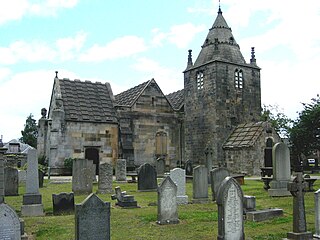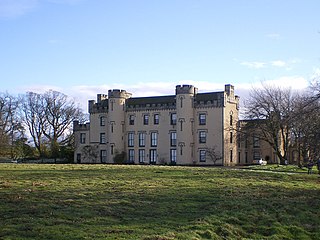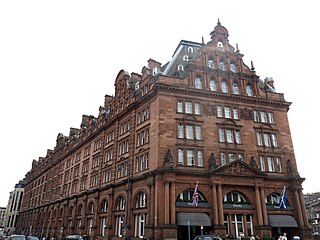
Lieutenant Colonel William Henry Dick-Cunyngham VC was a Scottish recipient of the Victoria Cross, the highest and most prestigious award for gallantry in the face of the enemy that can be awarded to British and Commonwealth forces.

Corstorphine is an area of the Scottish capital city of Edinburgh. Formerly a separate village and parish to the west of Edinburgh, it is now a suburb of the city, having been formally incorporated into it in 1920.

Duddingston Kirk is a Parish Church in the Church of Scotland, located adjacent to Holyrood Park in Duddingston Village, on the east side of the City of Edinburgh. Regular services are held at the kirk, conducted by the minister, Rev Dr James A. P. Jack.

The Grange is an affluent suburb of Edinburgh, just south of the city centre, with Morningside and Greenhill to the west, Newington to the east, The Meadows park and Marchmont to the north, and Blackford Hill to the south. It is a conservation area characterised by large early Victorian stone-built villas and mansions, often with very large gardens. The Grange was built mainly between 1830 and 1890, and the area represented the idealisation of country living within an urban setting.

Prestonfield is a primarily residential suburb in the south of Edinburgh, the capital of Scotland. It lies to the east of the A7 road, as it leaves the city centre, approximately 3 miles south of the centre. It is best known as being home to Prestonfield House, a renowned hotel, and Prestonfield Golf Club. The golf course is the nearest to the city centre. The area was developed with housing in the interwar period with a series of private bungalows by James Miller and others alongside a council estate designed by Adam Campbell and built under City Architect Ebenezer J MacRae.
Sir Alexander Seton of Pitmedden, 1st Baronet, Lord Pitmedden was a Scottish advocate, a Senator of the College of Justice, a Lord of Justiciary, and a Commissioner.

The House of the Binns, or simply the Binns, is a historic house and estate in West Lothian, Scotland, the seat of the Dalyell baronets and family. It dates principally from the early 17th century and was gifted to the National Trust for Scotland in 1944 by Eleanor Dalyell. It was the home of MP Tam Dalyell until his death in January 2017.

Coworth House, currently known as Coworth Park Hotel, is a late 18th-century country house situated at Sunningdale, near Ascot, in the English county of Berkshire. It is one of the ten hotels operated by the Dorchester Collection, a group of luxury hotels in Europe and the United States owned by the Brunei Investment Agency.

The Hotel Senator is a landmark building located in downtown Saskatoon, Saskatchewan, Canada. The building was built as the Flanagan Hotel by James Flanagan, an early settler in Saskatoon, and designed by Walter William LaChance, an architect who designed many local Saskatoon buildings at the turn of the century. When originally built, the hotel included many luxury features for 1907, including steam heating, hot and cold running water, telephones in each room and extensive use of marble and wood paneling. James Flanagan died in 1909; the hotel was subsequently sold in 1910 for $150,000 by his estate.

Henry James Moncreiff, 2nd Baron Moncreiff was a Scottish judge who succeeded to the title Baron Moncreiff.
The Dick baronetcy in Prestonfield, Edinburgh was created in the Baronetage of Nova Scotia for James Dick. Initially created in 1677, it was renewed in 1707 and merged with the Cunningham of Lambrughton, Ayrshire baronetcy in 1829. The family seat was Prestonfield House, Edinburgh. Sir William Dick, 2nd Baronet and Sir Alexander Dick, 3rd Baronet were the younger sons of Sir William Cunningham, 2nd Baronet and his wife Janet Dick, the daughter and heiress of Sir James Dick, 1st Baronet. Both brothers changed their surname to Dick on inheriting Prestonfield in turn.

Penicuik House survives as the shell of a formerly grand estate house in Penicuik, Midlothian, Scotland. The 18th-century palladian mansion was built on the site of an earlier house by Sir James Clerk, 3rd Baronet. It was destroyed by fire in 1899 and a major restoration, stabilising the ruin, was completed in 2014 by G Brown Stonemasons.

The Caledonian Edinburgh is a five-star hotel in Edinburgh, Scotland. Opened in 1903, it is an example of a British grand railway hotel. Nicknamed "The Caley", it stands at the west end of Princes Street and is a category A listed building.
Lady Anne Dick or Anne Cunyngham or Anne Mackenzie was a Scottish noblewoman, poet and eccentric. Some of her lampoons and verses are said to have embarrassed her friends.

Sir Alexander Dick, 3rd Baronet of Prestonfield PRCPE FRSE FSAScot was a Scottish landowner and physician, who rose to be President of the Royal College of Physicians of Edinburgh.
Sir James Dick of Prestonfield was a 17th and 18th century Scottish merchant who served as Lord Provost of Edinburgh from 1679 to 1681. He was the first Baronet of Prestonfield and was progenitor to the Dick baronets.

Sir William Dick of Braid (1580–1655) was a 17th-century Scottish landowner, banker and merchant who served as Lord Provost of Edinburgh from 1638 to 1640. His fortunes took him from being "the richest man in Scotland" in 1650 to his death as a pauper a few years later.
Thomas Hamilton, Lord Priestfield (c.1535–1611) was a 16th/17th century Scottish judge and Senator of the College of Justice.
Andrew Hamilton, Lord Redhouse was a Scottish landowner and Senator of the College of Justice.

Priestfield Parish Church is a parish of the Church of Scotland in Edinburgh. It is in the presbytery of Edinburgh. It is located approximately 1.5 miles (2.4 km) south of Edinburgh city centre on Dalkeith Road at its junction with Marchhall Place. The church building was completed in 1880 and is now a category A listed building.



















